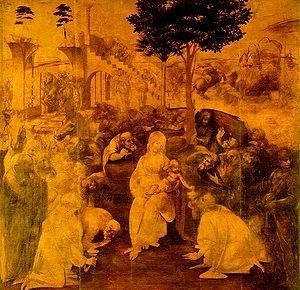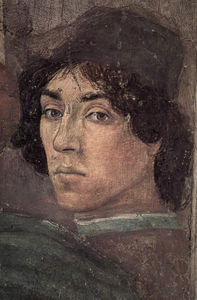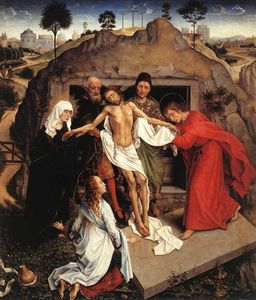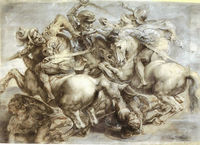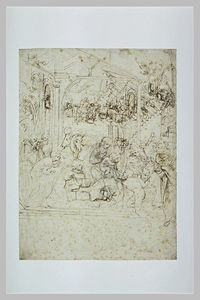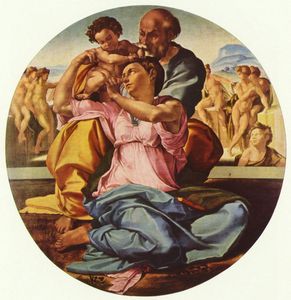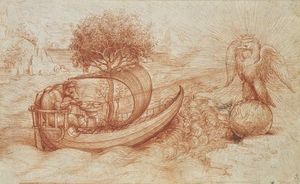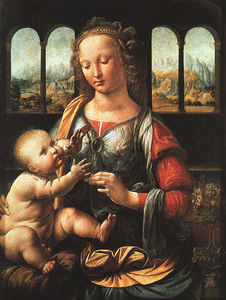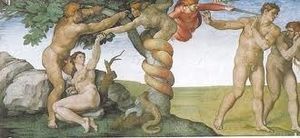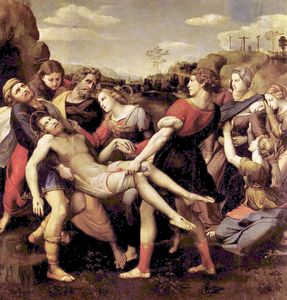Adoration of the Magi
- Date of Creation:
- 1481
- Height (cm):
- 246.00
- Length (cm):
- 243.00
- Medium:
- Oil
- Support:
- Wood
- Subject:
- Figure
- Assisted By:
- Domenico Ghirlandaio, Filippino Lippi
- Art Movement:
- Renaissance
- Created by:
- Current Location:
- Florence, Italy
- Displayed at:
- Galleria degli Uffizi
- Owner:
- Galleria degli Uffizi
- Adoration of the Magi Page's Content
- Story / Theme
- Inspirations for the Work
- Analysis
- Related Paintings
- Artist
- Art Period
- Bibliography
Adoration of the Magi Story / Theme
Adoration of the Magi was commissioned in 1480 for the main altar of the monastery of San Donato a Scopeto, near Florence. It was an ambitious project for the then 29-year-old Leonardo, and his father - who administered the monastery's finances - may have helped obtain the commission.
A complicated contract was drawn up which stated that the artist must complete the painting within two-and-a-half years otherwise he would not be paid for the work. His payment for the piece was unusual and included inheriting a portion of some land the monks had been left, among other things.
True to form, Leonardo abandoned Adoration of the Magi in 1482 when he set out for Milan having being offered a regular income by the Duke. The commission was taken up by Domenico Ghirlandaio and handed over to Filippino Lippi for completion.
Leonardo frequently failed to finish his commissions - he spent months solving compositional and content problems but quickly tired of painting the final piece. Despite its unfinished state, the Adoration of the Magi is considered one of the most important artworks from Leonardo's early career.
The theme of the three wise men (or Magi) worshipping the newborn Christ was common in early Renaissance art. Leonardo's version represents the moment when the second king offers his gift of frankincense, symbolizing the Eucharist, to the infant Christ who accepts it. This was a sign that Christ also accepted his fate.
The Virgin Mary and Child are shown in the center of the image and the three kings kneel before them in adoration. Behind them other figures form a semicircle and a young shepherd boy facing away from the crowd on the far right is believed by some to be a self-portrait of the young Leonardo. Featuring in their works was common practice among artists at this time.
In the background the ruins of a pagan building and the men on horseback engaging in combat represent the decline of pagan culture and the dawn of a new Christian era.
Adoration of the Magi Inspirations for the Work
The composition of the Adoration of the Magi draws heavily on the earlier works of Northern artist Rogier van der Weyden. There are many similarities between Leonardo's work and van der Weyden's Entombment of Christ such as the somewhat elevated viewpoint, space retreating into the distance, high horizon and positioning of the central group.
Adoration of the Magi Analysis
Composition:
Sixty-six humans and eleven animals have been counted in this image, making it a hugely ambitious project. The Madonna and Child are arranged in a pyramid shape, and their gaze is directed at the pyramid's side.
Leonardo employed this same compositional approach in a number of his later works.
Mood, tone and emotion:
This painting boasts a great deal of biblical symbolism; the Roman building, in the top left hand corner, is thought by many critics to be the Basilica of Maxentiu which, according to mythology, Romans believed would crumble upon the birth of a child to a virgin mother.
Behind the ruins is an area of countryside and men on horseback can be seen battling with a vicious beast. Ruins were also a commonly used sign of the loss of paganism after the birth of Christ and the palm tree directly behind the Virgin and Child is the Tree of Life.
Leonardo's work was also remarkable for the way he tried to express virtually human emotion in his depiction of animals.
Perspective:
The study created for the Adoration of the Magi (please see Related Works below) is much more detailed than the final painting and is rather different. It shows a group of men and animals on the balcony with nude figures climbing up the pillars, the arches and stairs appear in good condition and there is a camel quietly resting.
This is the only time a camel featured in Leonardo's art but this and the other elements listed above were altered or removed once the artist began painting the piece.
Use of technique:
Leonardo introduces a method that was later coined 'chiaroscuro' where there is greater contrast of light to dark the closer a character is to the center of the image.
Adoration of the Magi Related Paintings
Adoration of the Magi Artist
Leonardo da Vinci was a competent illustrator and his unique powers of observation meant that he could transfer what he saw in real life and its effects, more specifically those of nature, onto his canvas. A curious individual, he tried to explain what he saw and carried out detailed research and experiments to try out his theories.
His sketches and recordings in countless notebooks made him one of the first men to adopt a scientific approach towards understanding the world and how we view it. Many claim that da Vinci had one of the best scientific minds of his generation.
Leonardo's mission was to find a collective style for painting and with perspective and other realistic elements, he aimed to design truthful interpretations of the world around him. This was extremely bold in a culture previously dominated by highly emblematic and strange religious artworks, and this focus on objectivity became the standard for painters who emerged in the 16th century.
Though Adoration of the Magi was never completed by Leonardo, it is recognized as one of his most important works, produced at a time in his career when he was breaking away from the influence of his master, Verrocchio. It introduced into his painting a certain dreamlike quality with a menacing edge that would shape many of his later works.
More sketches were created for this artwork than any other piece by the artist and he dedicated much time to depicting landscape elements, drama and bold figure compositions. Consequently, the Adoration of the Magi is one of his best unfinished masterpieces.
Adoration of the Magi Art Period
In art history, the High Renaissance was a time denoting the pinnacle of the visual arts in the Italian Renaissance. Most agree that the High Renaissance began in the 1490s, with Leonardo's fresco of The Last Supper in Milan and ended in 1527 with the sacking of Rome by the troops of Charles V.
The High Renaissance was a time of outstanding artistic production in Italy and the best-known examples of Italian Renaissance painting derive from artists such as Leonardo da Vinci, Michelangelo and a young Raphael.
The images in the Vatican by Michelangelo and Raphael are the epitome of High Renaissance art and their size, ambitious compositions, detailed figures and iconographic references to classical antiquity, are emblematic of this period.
Although typically named as the three giants of the High Renaissance, Leonardo, Michelangelo and Raphael were not of the same age. Leonardo was the eldest; he was twenty-three when Michelangelo was born and thirty-one when Raphael was born. Raphael died in 1520 at the age of 37, the year after Leonardo, but Michelangelo's career spanned a further 45 years.
Adoration of the Magi Bibliography
To explore further about the life and works of Leonardo da Vinci please select from the following recommended sources.
• Brown, David Alan. Leonardo da Vinci: Origins of a Genius. Yale University Press, 1998
• Da Vinci, Leonardo. Drawings. Dover Publications Inc. , 1980
• Jones, Jonathan. The Lost Battles: Leonardo, Michelangelo and the Artistic Duel That Defined the Renaissance. Simon & Schuster Ltd. , 2010
• Kemp, Martin. Leonardo da Vinci: The Marvellous Works of Nature and Man. OUP Oxford, 2007
• Marani, Pietro C. Leonardo Da Vinci: The Complete Paintings. Harry N. Abrams, Inc. , 2003
• Syson, Luke. Leonardo Da Vinci: Painter at the Court of Milan. National Gallery Company Ltd. , 2011
• Vezzosi, Alessandro. Leonardo da Vinci: Renaissance Man. Thames & Hudson, 1997
• Zollner, Frank & Nathan, Johannes. Leonardo Da Vinci: The Complete Paintings and Drawings. Taschen GmbH, 2007

